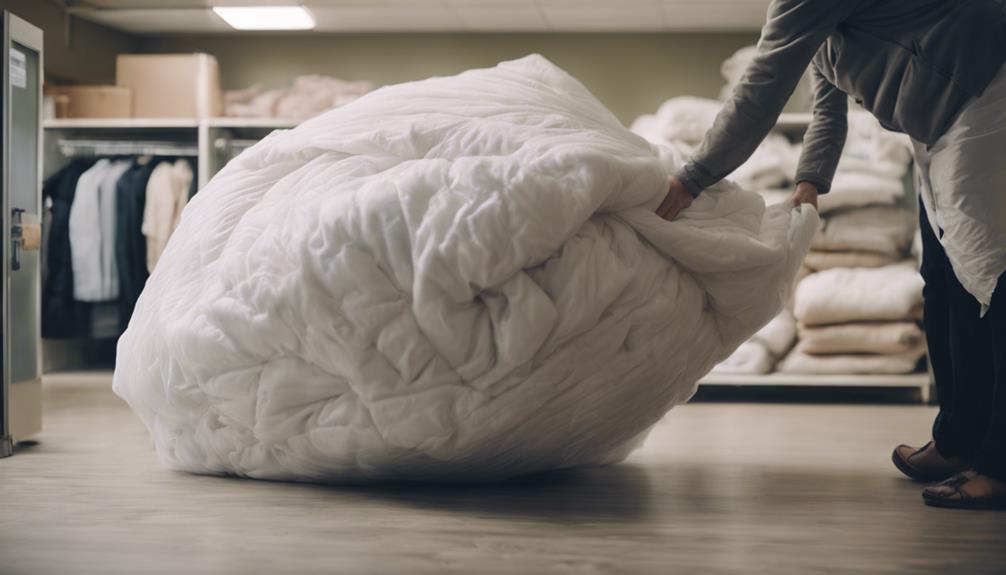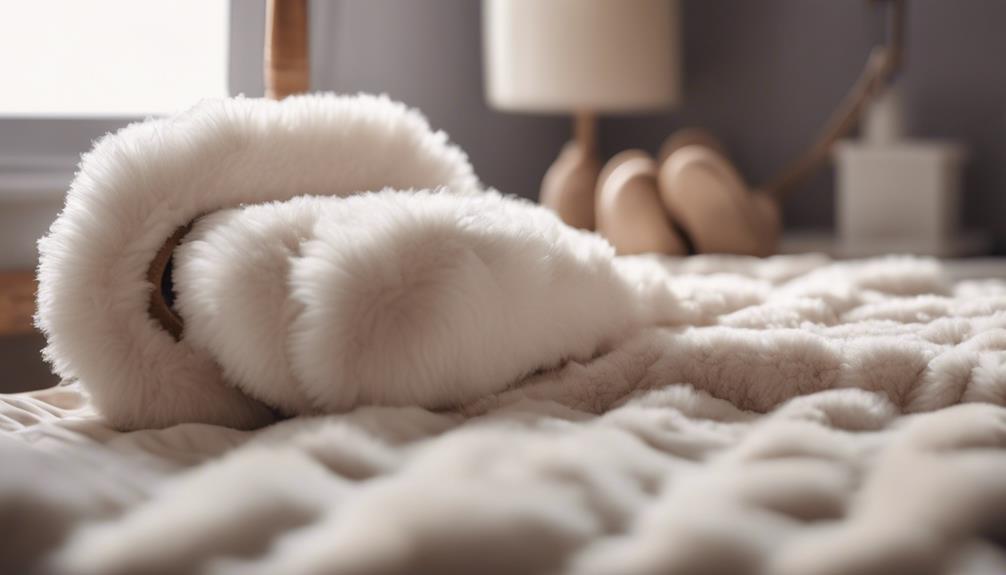When it comes to protecting your down comforter and keeping it clean, using a cover is a smart decision. It helps defend against dust, allergens, skin oils, and everyday wear and tear, ultimately prolonging its lifespan and comfort. Covers also provide an extra layer of coziness and help prevent shedding. When choosing a cover, consider factors like material options, sizing, and closure types. Covers make cleaning easier and less frequent than washing the comforter directly. To find out more about why covers are crucial for extending the life of your comforter and enhancing comfort, keep on exploring.
Key Takeaways
- Yes, a cover is essential for protecting your down comforter.
- Covers safeguard against dust, stains, and wear, extending comforter lifespan.
- Enhances cleanliness and maintenance, reducing the need for frequent washing.
- Adds an extra layer of coziness and style to your bedding.
- Improves overall sleeping experience by maintaining comfort and texture.
Importance of Down Comforter Covers
Down comforter covers play an important role in safeguarding your bedding and enhancing its longevity. These covers protect bedding from dust, allergens, and skin oils, keeping your comforter clean and fresh.
By acting as a barrier, comforter covers prevent wear and tear, ultimately extending the lifespan of your down comforter. Not only do they shield your duvet from direct contact, making washing easier, but they also enhance comfort.
Adding a duvet cover can provide an extra layer of coziness, improving your overall sleeping experience. Apart from the practical benefits, comforter covers also contribute to the aesthetic appeal of your bedding, giving it a stylish and put-together look.
It's clear that using a down comforter cover isn't just about protection; it's about ensuring your bedding remains in top condition while adding a touch of comfort and style to your bedroom.
Benefits of Using a Down Comforter Cover
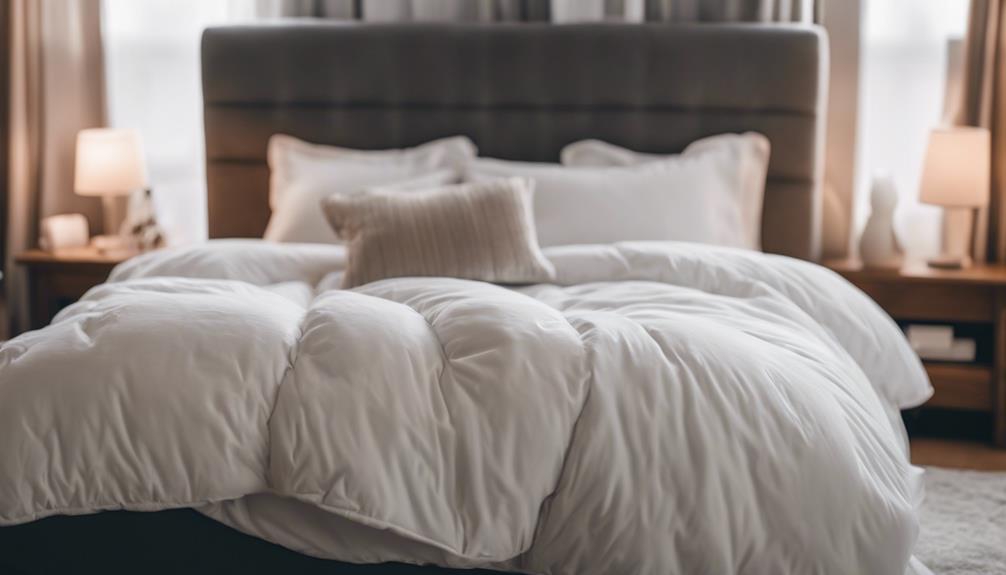
Enhancing the durability and cleanliness of bedding, utilizing a down comforter cover offers numerous advantages.
- Protects Your Comforter: A duvet cover acts as a shield, safeguarding your comforter from dust, allergens, and skin oils. This protection not only maintains the cleanliness of your bedding but also prolongs the lifespan of your comforter.
- Enhances Maintenance: Washing a duvet cover is a simpler task compared to washing the down comforter itself. The cover is easily removable and washable, making maintenance more convenient and efficient.
- Maintains Comfort and Texture: Using a cover for your down comforter prevents shedding issues and helps in preserving the texture of the duvet casing. This guarantees that your comforter stays cozy and visually appealing, enhancing your overall sleeping experience.
Factors to Consider When Choosing a Cover
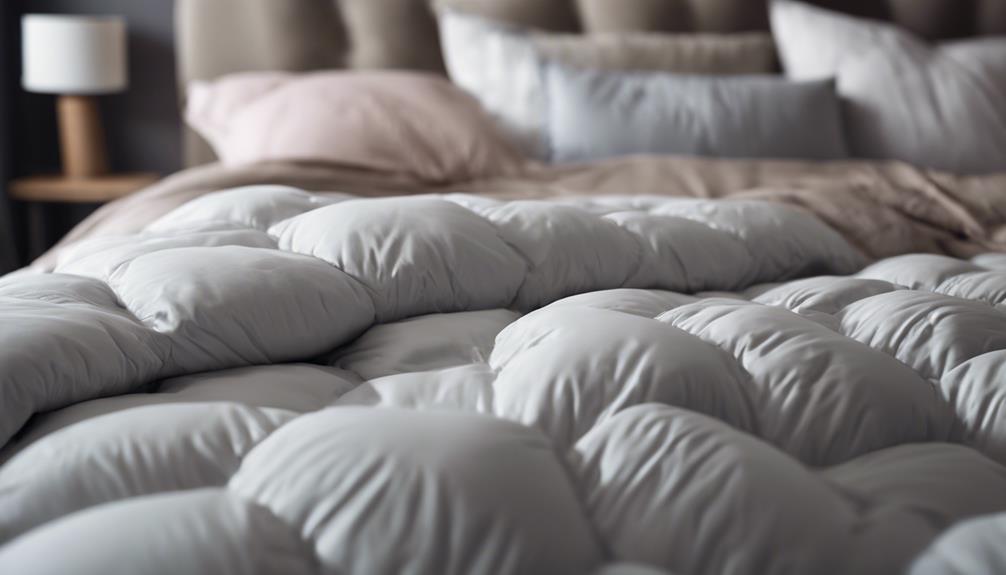
When selecting a cover for your down comforter, it's important to take into account factors like the material options available and ensuring the cover fits your comforter's size snugly.
The cover material can impact the quality and durability of your comforter, with choices like Egyptian cotton offering enhanced longevity.
Proper sizing and a good fit can make a significant difference in both the protection and aesthetic appeal of your bedding.
Cover Material Options
Selecting a cover material for your down comforter involves considering various factors such as the quality, durability, and maintenance requirements of the fabric. When choosing a cover, you may opt for:
- Egyptian Cotton: Known for its quality and durability due to finer spun fibers, providing a softer feel.
- Percale: Offers a lighter and more breathable option for duvet covers.
- Sateen: Provides a silky smooth surface for enhanced comfort.
These options allow you to tailor your choice based on personal preferences for comfort, breathability, and ease of maintenance. Opting for a washable, sheet-weight fabric like cotton can guarantee longevity and effortless care for your down comforter.
Size and Fit
Considering the dimensions of your down comforter is crucial when choosing a cover for the best fit and functionality. Make sure the cover size matches your comforter's dimensions to prevent shifting or bunching.
Covers are available in standard sizes like Twin, Full, Queen, and King to correspond with your comforter size. Opting for a cover slightly larger than your comforter can offer a relaxed, draped appearance.
To guarantee compatibility, measure your comforter's dimensions and compare them with the cover size options. This simple step can help you select the ideal duvet cover for your comforter, ensuring a snug and aesthetically pleasing fit.
Types of Down Comforter Covers
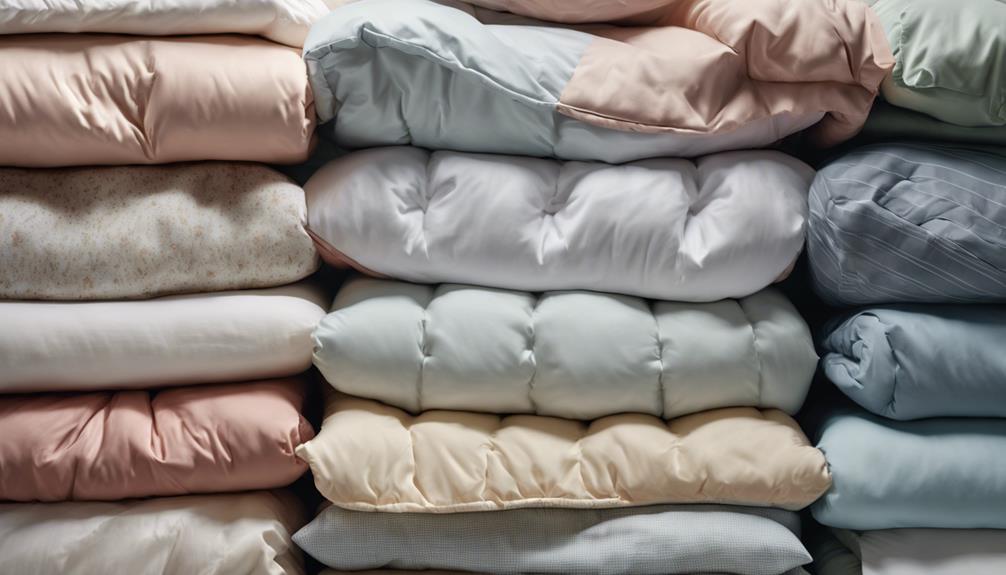
Exploring the variety of closure types available for down comforter covers reveals options like zippers, buttons, ties, or envelope closures. When choosing a cover, hidden button closures are recommended for their convenience and durability.
Additionally, covers with flanged construction offer extra coverage for thick mattresses and provide a tailored look. Opting for washable fabrics, such as sheet-weight cotton, guarantees easy maintenance of your down comforter cover.
To avoid upholstery-grade fabrics, as they can add excess weight and discomfort. By selecting the right closure type and fabric for your down comforter cover, you can enhance both the aesthetic appeal and practicality of your bedding.
Why Covers Extend Comforter Lifespan
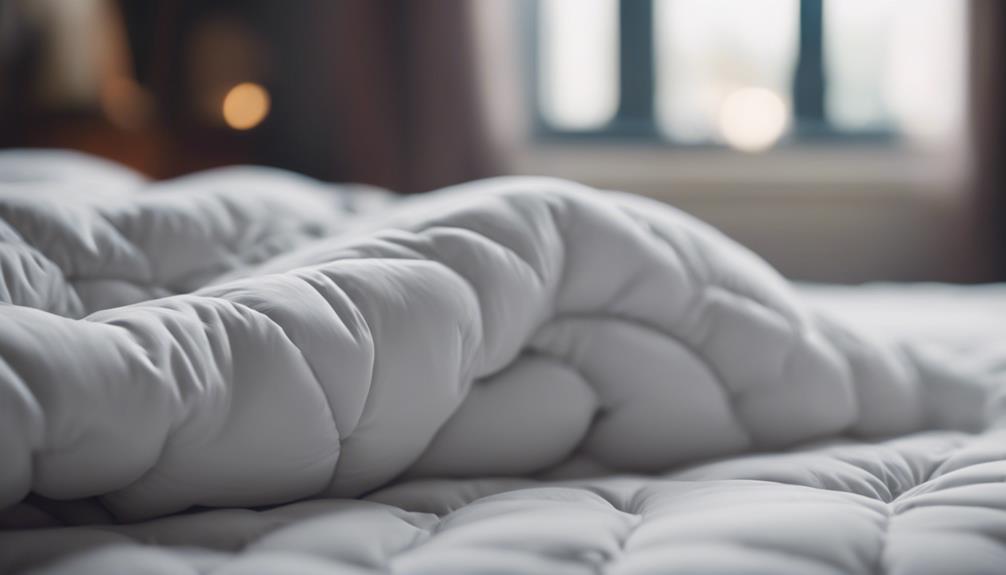
Duvet covers shield down comforters from stains and are an effortless cleaning solution. They help extend the lifespan of the comforter by providing a protective barrier against dust, allergens, and skin oils.
This simple addition can make maintenance easier and keep your comforter in top condition for longer.
Protection Against Stains
Using a down comforter cover not only protects against stains but also helps extend the comforter's lifespan. Duvet covers shield the comforter from spills, dirt, and oils, ensuring it stays clean and fresh for longer.
Additionally, covers act as a barrier against skin oils and hair products that can seep into the comforter, maintaining its quality. Washing a duvet cover is much easier than washing the down comforter itself, making it more convenient to keep your bedding clean.
Easy Cleaning Solution
How do duvet covers contribute to extending the lifespan of down comforters?
Duvet covers play an important role in protecting down comforters from dust, allergens, and skin oils, ultimately prolonging their longevity. Washing a duvet cover is much simpler and more convenient than washing a down comforter itself, reducing the need for frequent cleaning of the comforter.
By using a duvet cover, you can minimize the frequency of washing the down comforter, helping to maintain its quality over time. Additionally, duvet covers prevent shedding issues that may arise with feather-filled comforters, further enhancing the overall maintenance and durability of the down comforter.
Essentially, utilizing a duvet cover is an easy and effective cleaning solution that can greatly extend the lifespan of your down comforter.
How Covers Enhance Bedroom Aesthetics

Enhancing bedroom aesthetics with covers is a simple yet effective way to elevate the overall look and feel of the room. Duvet covers play an important role in enhancing bedding decor by adding a layer of style and sophistication. Here are three ways covers can enhance your bedroom aesthetics:
- Protection: Covers not only add style but also provide protection for your down comforter. They act as a shield, keeping your comforter clean and extending its lifespan.
- Changing Style: One of the main benefits of duvet covers is their ability to easily change the style of your bedding. By swapping out covers, you can effortlessly update the look of your bedroom without having to replace the entire comforter.
- Color, Patterns, and Textures: Covers offer a wide range of options to add pops of color, patterns, or textures to your bedroom design. Whether you prefer a bold statement or a subtle touch, covers can help you achieve the desired aesthetic.
Cleaning and Maintaining Your Cover

When it comes to caring for your duvet cover, regular washing is key to maintaining its quality and extending its lifespan. Duvet covers are easier to wash compared to down comforters, making maintenance simpler. Washing comforters repeatedly can impact their lifespan, while duvet covers offer protection. Using a duvet cover protects the comforter and minimizes the need for frequent washing. However, it's essential to choose the right type of duvet cover to ensure proper maintenance. Opt for duvet covers made from breathable materials to prevent the trapping of air and moisture, which can affect the performance of your down comforter. Additionally, selecting duvet covers with hidden button closures can enhance durability and convenience in cleaning.
| Duvet Cover Maintenance Tips | |
|---|---|
| Regular washing is key | Opt for breathable materials |
| Protects comforter | Choose hidden button closures |
| Minimizes frequent washing | Avoid heavy fabrics |
| Extends cover lifespan | Ensure proper fit for comforter |
Ensuring Proper Fit for Your Comforter
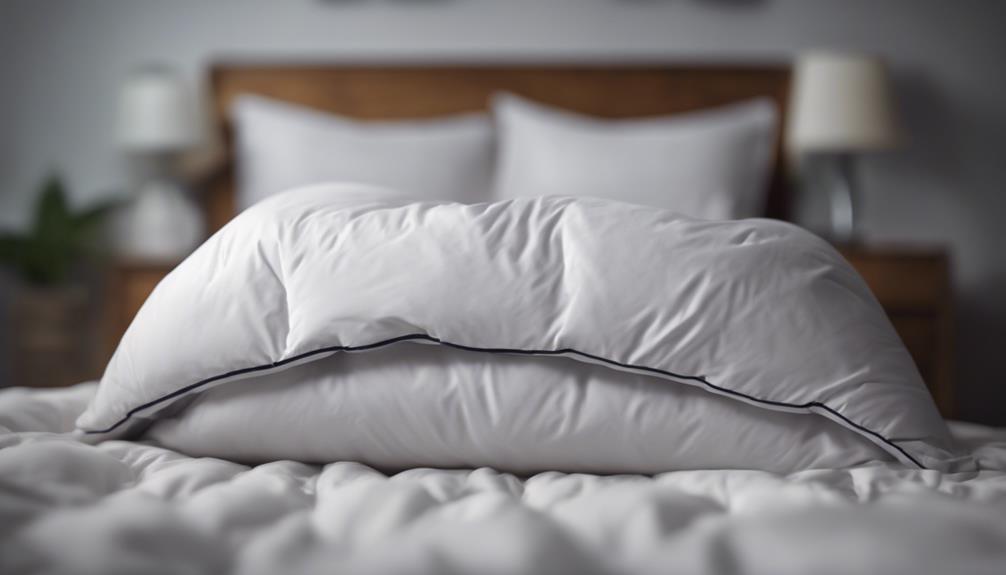
To guarantee your comforter fits properly, selecting a cover that matches its dimensions is essential for preventing shifting or bunching. When choosing a cover for a duvet filled with down feathers, consider the following:
- Check the Size: Make sure the cover is the right size for your duvet insert to prevent any excess fabric that can lead to bunching inside the cover.
- Look for Zipper Closure: Opt for a cover with a zipper closure to securely encase your comforter and prevent it from slipping out during use.
- Consider the Fill Material: Since your duvet is filled with down feathers, choose a cover that's soft and breathable to complement the luxurious feel of the comforter while providing adequate protection.
Maximizing Comfort With a Cover
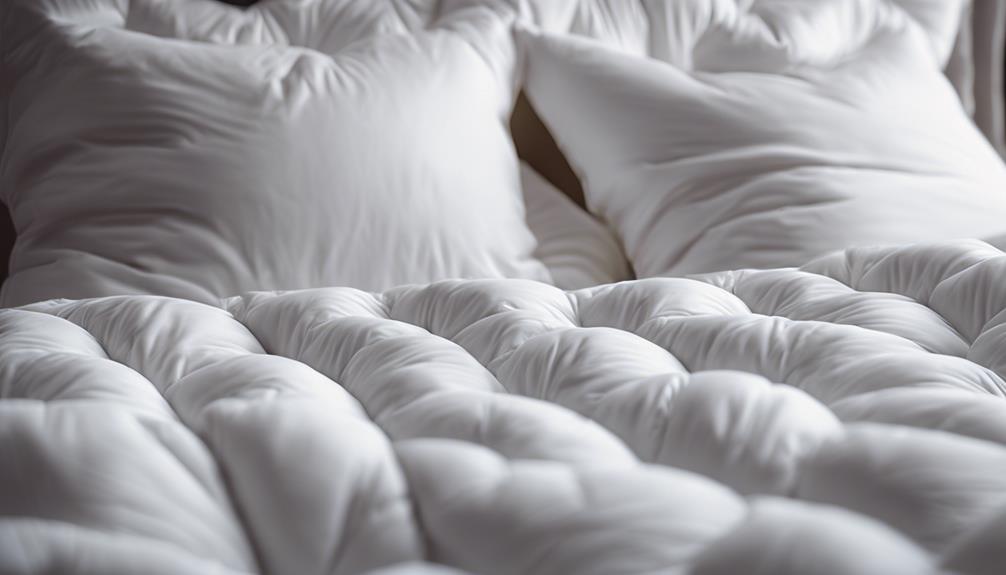
We guarantee maximum comfort by selecting a cover that perfectly fits our down comforter, enhancing both coziness and longevity. Using a duvet cover not only adds a stylish touch to your bedroom decor but also protects your comforter from dust, allergens, and skin oils. This protection helps extend the lifespan of your down comforter, saving you money in the long run. Additionally, covers make cleaning a breeze since they are removable and washable, eliminating the need to wash the entire comforter frequently. By investing in a quality duvet cover, such as one made from Egyptian cotton, you can further enhance the comfort and durability of your down comforter. Not only do covers shield your comforter, but they also maintain its quality and texture, preventing shedding and ensuring lasting comfort for a restful night's sleep.
| Protects from Dust | Removable & Washable | Enhances Decor | Extends Lifespan |
|---|---|---|---|
| Yes | Yes | Yes | Yes |
Where to Find Quality Comforter Covers

For those seeking premium comforter covers, Pacific Coast Bedding is a prime destination known for its high-quality selection. Comforter covers are essential to protect and enhance the lifespan of your down comforter. Here are three reasons why Pacific Coast Bedding stands out for comforter covers:
- High-Quality Stitching: Pacific Coast Bedding offers a variety of comforter covers with meticulous stitching, ensuring durability and longevity for your bedding.
- Exceptional Layer of Protection: Comforter covers provide an additional shield against stains and wear, keeping your down comforter in pristine condition for years to come.
- Preserve Quality and Appearance: Using a comforter cover not only safeguards your down comforter but also helps maintain its quality and appearance over time, ensuring you can enjoy its warmth and comfort for longer periods.
When it comes to finding exceptional comforter covers that protect and enhance your down comforter, Pacific Coast Bedding is a reliable choice with a reputation for excellence.
Frequently Asked Questions
Are Comforter Covers Necessary?
Comforter covers are indeed necessary to protect your down comforter. They prevent stains, spills, and damage, thereby extending the comforter's lifespan. Covers are also essential for easier cleaning and maintenance.
Additionally, they offer a decorative element to your bedding and allow for style changes without replacing the comforter. Investing in a cover can save money in the long run by safeguarding your down comforter from wear and tear.
How Do I Protect My Down Comforter?
To protect your down comforter, consider using a washable duvet cover. This cover shields your comforter from dust, allergens, and skin oils, extending its lifespan. It's easier to clean the cover than the comforter itself, improving overall comfort and cleanliness.
Plus, duvet covers come in various designs, adding aesthetic appeal to your bedding. So, investing in a cover can keep your down comforter in top condition and enhance your bedroom's look.
Do You Put Something Over a Down Comforter?
Putting something over a down comforter, like a cover, is beneficial. Covers shield the comforter from dust, allergens, and oils, enhancing cleanliness and longevity. Washable covers make maintenance easy.
They add a layer of comfort, improve sleep quality, and can elevate the look of your bedding. In short, using a cover for your down comforter is a wise choice with practical and aesthetic advantages.
Can You Use a Down Alternative Comforter Without a Duvet Cover?
Yes, you can use a down alternative comforter without a duvet cover, but it's recommended to enhance protection and style. A duvet cover helps shield your comforter from dirt, oils, and wear, extending its lifespan. Without one, your comforter may be more prone to staining, tearing, and losing fluffiness.
Plus, duvet covers make it easy to change your bedding's look and add warmth. Opt for a cover to improve comfort and appearance.
Is a Duvet Cover Necessary for Protection and Maintenance of a Down Comforter?
Yes, a duvet cover for comforter is necessary for protection and maintenance of a down comforter. It helps to keep the comforter clean, reducing the frequency of washing which can damage the delicate feathers inside. It also adds a stylish touch to your bedding while providing an extra layer of insulation.
Conclusion
To sum up, when selecting a cover for your down comforter, it's crucial to take into account its importance for extending its lifespan, maximizing comfort, and ensuring easy maintenance.
By choosing a high-quality cover that fits properly, you can safeguard your comforter from wear and tear while enjoying a cozy night's sleep.
Keep in mind to evaluate factors such as material, size, and cleaning instructions to discover the ideal cover for your needs.
Invest in a cover today to elevate your sleeping experience.




